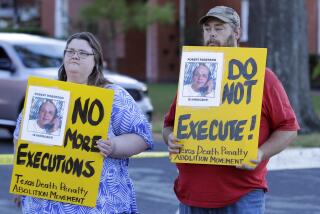The Art of Execution, Texas Style
- Share via
HUNTSVILLE, Texas — It’s not an easy task to start with, and so much, so very much can go awry.
Machine failure, human error, tricky new equipment. Sheer nerves, the media. Cramped quarters for the visitors, uncertain or unpracticed staffers. And the hardest part of all, the part only perfectible with constant practice: what to say to a condemned man as potassium chloride solution invades his blood.
It’s a strange, taxing craft, performing executions, and Texas, many wardens say, performs it best. Drawn by the state’s record pace of executions, wardens from California, Alabama and New Mexico--among others--are quietly paying visits here to watch the experts work.
At least half a dozen have received this informal tutelage, during which they typically follow a condemned man through his final day, from the Terrell Unit, where he is housed, to a witness cubicle facing the death room at the nearby Huntsville Unit.
The visiting officials recall the details vividly. Observing a prisoner’s final day, they say, offers rare guidance into a complex, haunting task about which many wardens feel ambivalent.
No school, no guild, no professional fraternity links wardens from the 38 states that wield the death penalty. But, these administrators say, shepherding an inmate to his death demands skills, both technical and personal, that they cannot learn from reading.
“I went there to learn the process. You can’t learn those kinds of things in a manual,” said 58-year-old Dan Vasquez, who visited Huntsville while warden of San Quentin in 1997. Now warden of a private prison in California City, he went to Texas as California prepared to let condemned inmates choose between the gas chamber, which the state already used, and newly implemented lethal injection.
“I felt I had to actually be there,” said Vasquez, “to see the mixture of the chemicals and how they’re transmitted, and how they’re utilized. There are quantities and mixtures and levels of mixtures.”
Since the death penalty was reinstated in the 1970s, Texas has executed 211 inmates. About 450 more are on death row. Virginia, with the second highest number of executions, has performed 76. California has executed eight inmates in the same time period.
Death penalty opponents, unsurprisingly, see little to impress in either the state’s execution record or its performance.
“We’ve had people’s veins explode during the execution ritual,” said Houston prisoners’ advocate and radio host Ray Hill. “Because of American Medical Assn. rules, it’s not doctors who insert the needles; you have people with little or no medical training. When they screw up really badly the death chamber curtain gets slammed closed. Then you had Ponchai Wilkerson.” Wilkerson was executed last month for a 1990 murder/robbery. Waiting until the lethal liquid hit his bloodstream, the dying Wilkerson appalled witnesses by spitting out a hidden handcuff key that could have loosed his shackles.
But to wardens making pilgrimages to Huntsville, Texas’ mastery of lethal injection is supreme.
“We felt like, the more frequently you do something, you get more proficient at it. We figured they would have seen the whole range of things that can happen-- what the pros and cons are, figuring out the best way to administer lethal injection,” said John Hamm, a spokesman for the Alabama prison system. Hamm and others came to Huntsville for the February execution of 27-year-old Cornelius Goss, convicted of beating a man to death with a board.
A Prisoner’s Final Hours
Alabama’s delegation especially wanted to ensure continuity on their death row. Legislators for the state, which uses electrocution, are considering four bills that call for using injection instead.
“We wanted to be prepared if the switch did occur so we wouldn’t have any undue delays in execution,” Hamm said.
So Hamm, along with the deputy warden of Alabama’s death row unit and two other state officials, spent the day at Huntsville, observing, step by step, Goss’ final hours. Huntsville Warden Jim Willett met them at the red-brick building.
“He’s such a super-nice guy,” Hamm said. “He explained the procedures, then we actually went and looked at the death chamber. Looked at the table, how they had set up. How the witness rooms were.”
Unlike some states, Hamm explained, Texas offers two witness rooms outside the death chamber: one for the victim’s family, one for the family of the condemned. If Alabama adopts lethal injection, the state will remodel to create at least one witness room, plus a special, separate room for the injection to be administered by unseen prison personnel.
There was technical information to be gleaned at every turn.
“We wanted to know about their equipment. Did they buy the gurney or did inmates make it?” Hamm recalled. (Inmates built it.)
“Did they use a manual method of injecting the drugs or a machine?” (They inject them manually.)
“Who do they get to actually install the IV, because you get an ethics issue with physicians and nurses.” (Texas uses paramedics.)
Hamm also admired the Texas system for preserving inmates’ final words, a detail that Alabama officials had never thought of. “When inmates make it, it is being transcribed. After the execution, [the warden] has a copy of that, and he hands it out to the media.” In Alabama, by contrast, Hamm would probably paraphrase what he remembered, if anybody asked.
Other wardens bring different concerns, like those from New Mexico, readying for its first execution since 1960. Officials wanted to ensure they conducted their procedures as humanely as possible, said spokesman Gerges Scott, who went with the state’s penitentiary warden to watch the Sept. 21 execution of electrician Richard Wayne Smith for a 1992 murder and robbery. Like Hamm, Scott was dazzled by Texas’ seamless protocol.
‘As If It Were the First’
“What I saw was a very professional, humane and dignified process,” he said. “Some of the things I noticed were the personal touch that the warden and public information officer in Texas had. While, obviously, they have [performed] many executions in the past, they treated this as if it were the first, with a lot of compassion.”
Expecting considerable attention for two executions this summer, they also paid special attention to Texas’ practiced way with the media. Especially intriguing to Scott was the prison system’s Web site, including a detailed chart with names, execution dates, last words and final meals of every condemned inmate. (Most requested item: hamburgers.)
In the death chamber as Smith died were Warden Willett and the prison chaplain.
“One thing I was surprised about was how quick the actual execution was,” said Scott, who watched from the witness room. “It was within a matter of seconds.”
Although visiting wardens ask varying questions, they really have the same underlying concerns, said Don Cabana, a former Mississippi warden who participated in four executions before retiring in 1991. Understandably, the retired Cabana voices personal views far more freely than colleagues still on the job in public agencies.
“I understand what they’re saying when they say it’s done professionally--I think that encompasses a lot of different things,” Cabana said. “People don’t understand the effect that executing a human being has on the people who do it. It’s something you live with for the rest of your life. You do want it to go quickly, smoothly. You want it to be as humane and compassionate as possible.
“But lurking under the surface, a botched execution is just a public relations nightmare.”
Cabana, now a criminal justice professor at the University of Southern Mississippi, wrote “Death at Midnight,” a memoir of 25 years in corrections work. He now opposes the death penalty, saying the last execution he oversaw helped convince him to retire. And he believes that most wardens who administer it are gnawed by deep ambivalence.
“I could hardly be accused of being soft on crime or a do-gooder,” Cabana said in the plain, measured cadence of his native Ohio. “But one of the reasons I wrote a book when I retired was because most wardens can’t afford to speak out while on the job.”
Potential for Malfunctions
Wardens are right, Cabana said, to crave details on the craft of execution. Much can go wrong technically. With lethal injection, the most common problem is trying to run the fatal IV into an ex-substance abusers’ ruined veins. Some executions reportedly have taken more than an hour as paramedics stick and re-stick futilely.
Electric chairs can malfunction, as when one shot flames during Florida inmate Pedro Medina’s execution in 1997. Gas chambers have spit fumes irregularly or in inadequate proportions. Paradoxically, Cabana said, the less often a prison executes, the more chance for snafus with disused equipment or nervous staffers.
But the phase that often rattles wardens most is simply escorting someone they’ve known a decade--or more--to die.
“If you have someone who’s in the prison for 15 to 20 years, you have a sense that when you take him into the execution chamber, you’re not taking the same guy in there that came into the prison,” Cabana said.
Three-strike rules and longer prison sentences have only increased the number of inmates whom wardens get to know over long stretches. And though wardens admire Texas for its turbine-like efficiency, some instead study the technique of Warden Burl Cain at Louisiana’s prison in Angola.
Known for accompanying inmates at their final meals, Cain is wont to hold a condemned man’s hand as long as there is breath, murmuring reassurance that he will awaken in a better place.
Cain may be unusual, but his impulse also reflects a psychological survival skill for wardens.
“I think deep down inside most wardens are kind of hoping these guys are going to grant absolution to them,” Cabana said. “In the executions that I did, they invariably would tell me, ‘I don’t hold you responsible.’ I think if you walk away from an execution, and you don’t hear those words, I think there’s always something about that that stays in your mind.”
No matter how refined the chemistry, how respectful the last dispatch, technique can never mask what execution is, said California’s Vasquez. After he returned from Huntsville, he said, he set up a prestress therapy program for San Quentin’s staff. The philosophy was simple: He saw his execution team as trauma survivors.
Difficult Responsibilities
Retired, like Cabana, Vasquez also bluntly voices doubts about whether executions pose any kind of crime deterrent. The two men he helped execute may not kill again, but he didn’t see their deaths impeding other criminals.
Still, Vasquez, whose reflective manner belies a career in the prison business, voiced no regrets about working on death row. He took a job with tough responsibilities, responsibilities only a handful of people ever have to bear.
That’s why he chose to visit Texas during the two years he oversaw San Quentin executions. Not because Texas was so efficient, but because the warden at the time, Jack Pursley, was his friend.
“He trusts me, and I trust him. I went to him to ask him if he would teach me what I had to learn,” said Vasquez. “He’s a good man, a family man, and I think the world of him.
“He carried out over 60 executions. To me, a man who has the stamina to carry that out and not to change, to be the decent person that he was and is, that is a man.”
More to Read
Sign up for Essential California
The most important California stories and recommendations in your inbox every morning.
You may occasionally receive promotional content from the Los Angeles Times.










